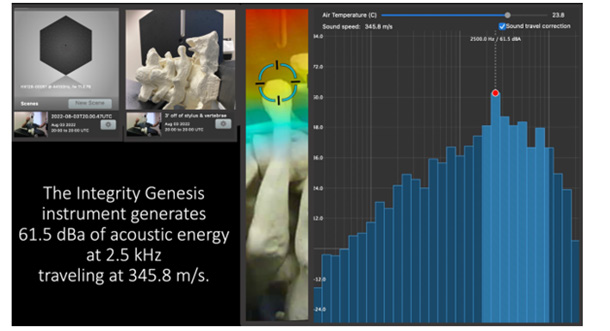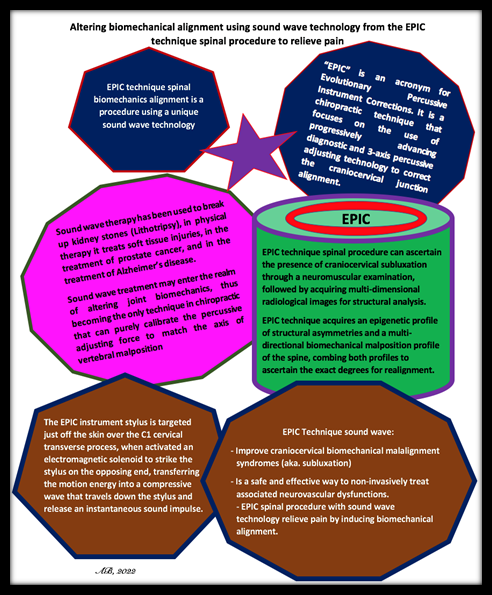Review Article 
 Creative Commons, CC-BY
Creative Commons, CC-BY
EPIC Spinal Procedure with Sound Wave Technology Induces Biomechanical Alignment Putatively Influencing Pain Response
*Corresponding author: Kenneth Blum, Division of Addiction Research & Education, Center for Mental Health & Sports Psychiatry, Western University of Health Sciences, Pomona, CA 91766, USA.
**Co-Corresponding author: Ashim Gupta, Future Biologics, Lawrenceville, GA 30043, USA.
Received: August 03, 2023; Published: August 16, 2023
DOI: 10.34297/AJBSR.2023.19.002642
Abstract
Spinal biomechanical alignment is now able to be altered through the use of unique sound wave technology. This methodological commentary will correlate recent studies demonstrating the ability of sound waves to carry mass, how the EPIC technique spinal procedure uses a sound wave impulse to create measurable changes in spinal alignment, and the clinical safety and efficacy of this approach. The EPIC technique is a direct genealogical descendant of the technique originally developed by the founding family of chiropractic. With sound wave therapies currently being used to break up kidney stones, called lithotripsy, in physical therapy for the treatment of soft tissue injuries, in the treatment of prostate cancer, and in the treatment of Alzheimer’s disease, it is possible that the use of sound wave therapies may enter into the realm of altering joint biomechanics. Through a neurovascular examination, the EPIC technique spinal procedure can ascertain the presence of craniocervical subluxation, followed by acquiring multi-dimensional radiographic images for structural analysis. Currently using digital radiographic analysis, the EPIC technique acquires an epigenetic profile of structural asymmetries as well as a multi-directional biomechanical malposition profile of the spine, combining both profiles to ascertain the exact degrees for realignment. EPIC clinics have successfully utilized EPIC on over 20,000 cases. Comparison of pre-treatment biomechanical lateral displacement of the C1 vertebra around the Z-axis measured on digital radiographs, and post-treatment biomechanical lateral displacement of the C1 vertebra measured on digital radiographs immediately following the procedure, demonstrated an average 52% reduction in lateral biomechanical displacement around the Z-axis in a select group of over 2,000 cases. While more research is required, we are encouraged by these preliminary results. WC 265
Keywords: EPIC, Spine, Pain, Global health, History of subluxation, Chiropractic, Sound wave technology and biomechanical alignment, Craniocervical, Subluxation, Neck Pain
Introduction
History of Subluxation
Inside the chiropractic profession, there are many diverse procedures and approaches to spinal care. Although each individual Doctor of Chiropractic (DC) may practice chiropractic with their own individual systems and techniques of care, those procedures are rooted in established techniques taught in the curriculum of various chiropractic colleges and universities. One of those established techniques is called EPIC. “EPIC” is an acronym for Evolutionary Percussive Instrument Corrections. It is a chiropractic technique that focuses on the use of progressively advancing diagnostic and adjusting technology to correct the craniocervical junction alignment [1].
The EPIC technique is a direct ancestor of the technique originally created by the founding family of chiropractic. Daniel David Palmer, DC, discovered and defined spinal “subluxation” in 1895 as a condition of the spine in which a vertebra has lost its proper juxtaposition to the point of impairing the function of the nervous system. Bartlett Joshua Palmer, DC, Daniel David Palmer’s son, spent a lifetime of chiropractic research and came to the conclusion that the primary direction of the nervous system’s flow is from the brain, down the spinal cord, and out the nerves to the affected/ controlled areas. This concept is known as ADIO (Above-Down-Inside- Out). Based upon this concept, Bartlett Palmer developed the Hole-In-One (HIO)/Toggle technique in the early 1900s, which focused on evaluating and treating the two upper cervical vertebral misalignments in an area that he called “the true subluxation [2].” The presence of the subluxation’s neurologic imbalance was established through neurophysical examination.
Subluxation Details for Adjustment
The direction of atlas (C1) malposition was determined by radiographic evaluation and was defined through positional listings (i.e., Atlas Superior Left Posterior (ASLP), Atlas Inferior Right Posterior (AIRP), etc.) to give the chiropractor a general understanding of which way to adjust it. The axis (C2) malposition was given a different general designation from the radiographs and needed a separate adjustment. The neurophysical criteria were reviewed after the adjustment to evaluate any changes, but it was not considered standard practice to take post-adjustment radiographs.
Palmer’s approach was the foundation of the science, results, and public perspective of the beginning of the chiropractic profession and was called the Toggle technique. In the 1930s, John Grostic, DC, improved the radiographs and calculated angles used to evaluate cervical malposition and quantified these malpositioned vertebrae on a mathematical engineering platform standardizing the use of post-adjustment radiographs [3]. In the 1970s, Roy Sweat, DC, developed a 2-axis, table-mounted, adjusting instrument that could deliver a percussive soundwave to align the upper cervical spine [3]. In 2001, the lead author, Stan Pierce, DC, and his father, Stan Pierce Sr., DC, advanced and refined the radiographic analysis protocol to include data transposition between radiographs for anatomical clarity, methods to validate reference line determination and measurement accuracy, and evaluation methods to determine genetic abnormalities that would affect the understanding of each patient’s “normal” position into which they needed to be adjusted [4]. This technique was known as the Advanced Orthogonal technique, involving streamlined imaging analysis to assist in removing analysis errors through advanced software coding [5]. In 2015, Stan Pierce, DC and his technique board rebranded the technique to Evolutionary Percussive Instrument Corrections (EPIC), further enhanced the analysis of the epigenetic profile, refined biomechanical influences, and created a statistical standardization of care. EPIC also created patented laser targeting and invented the first 3-axis percussive adjusting instrument, thus enabling the unique ability to purely calibrate the percussive adjusting force to match the axis of vertebral malposition.
Sound Waves in Spinal Care: A Historical Perspective
In 2015, scientists from the Department of Mechanical Engineering at the University of Bristol provided the first demonstration of the ability to levitate and manipulate multiple objects simultaneously through the use of sound. This led them to surmise that, in the near future, surgeons may use “acoustic tweezers” to trap and manipulate selected objects within tissue [6].
In 2019, researchers at the University of Oregon published an article in Physical Review Letters titled “Gravitational Mass Carried by Sound Waves” in which they show that sound waves do carry mass – in particular, gravitational mass [7].
In 2020, researchers at the Institute of Theoretical Science and at the University of Oregon published an article in Physical Review Research titled “Sound waves move matter” where they consider a wave packet moving in the Z direction with an amplitude that is independent of the X and Y. They analyze that at second order in an expansion around small-amplitude vibrations, there is a small net motion of material, and thus mass, that is generated as a straightforward consequence of Newton’s laws [8].
With sound wave therapies currently being used to break up kidney stones, called lithotripsy, in physical therapy for the treatment of soft tissue injuries, in the treatment of prostate cancer [9], and in the treatment of Alzheimer’s disease [10], it is possible that the use of sound wave therapies may enter into the realm of altering joint biomechanics.
The EPIC technique spinal procedure is an approach in the spinal care industry that utilizes sound wave treatment technology to alter the biomechanical alignment of the craniocervical junction. The protocols of the EPIC technique spinal procedure were published in 2021 [5,11]. Whereas abnormal biomechanical spinal alignment (aka. spinal subluxation) in the craniocervical region has been correlated to altering neurologic dysafferentation and cranial hemodynamics, this craniocervical subluxation has the potential to directly and/or indirectly contribute to the possible negative sequelae of many different conditions. Many pain syndromes are a direct and/or indirect effect of an uncorrected craniocervical subluxation.
Descriptive of Biomechanical Alignment Using Sound Wave Technology from The Epic Technique Spinal Procedure
Through a neurovascular examination, the EPIC technique spinal procedure can ascertain the presence of craniocervical subluxation, followed by acquiring multi-dimensional radiographic images for structural analysis. Using digital radiographic analysis, the EPIC technique acquires an epigenetic profile of structural asymmetries as well as a multi-directional biomechanical malposition profile of the spine, combining both profiles to ascertain the exact degrees for realignment. These coordinates are then calibrated into the Integrity Genesis instrument, an FDA-registered 3-axis sound impulse generator device (Figure 1), by angulating the instrument on the calculated coordinates, aka “vectors.
The instrument stylus is targeted just off the skin over the C1 cervical transverse process (Figures 2,3). The device is activated to initiate an electromagnetic solenoid to strike the stylus on the opposing end, transferring the motion energy into a compressive wave that travels down the stylus and releases as an instantaneous sound impulse. With the cervical vertebral transverse process being at an average minimum depth of ¾”-1”, there is no direct contact between the stylus and the vertebra. Any force transmission would have to travel through approximately 1” of soft tissue to affect the osseous structure.

Figure 3: Demonstrates the angulated targeting of the stylus for the sound wave impulse to reach the C1 vertebra at its location 1” deep on the correct coordinates.
Acoustic force generation of the Integrity Genesis instrument was measured using ARTVIS (Acoustic Real-time Video Imaging System) technology. ARTVIS diagnostics reveal the force generation of the Integrity Genesis instrument generates 61.5dBa at 2.5kHz, traveling at a speed of 345.8m/s. (Figure 4) at the 1” depth from the stylus.
A digital force evaluation performed with a linear accelerometer (aka “testing agent”) was set at 1” from the stylus tip. It revealed that when the stylus of the Integrity Genesis instrument was aimed directly over the testing agent, it generated a Z-axis linear force of .02 m/s2 acceleration and a cumulative linear force of .07-.08 m/ s2 (Figure 3). The sequence of 5 measured strikes in (Figure 5) from correlating instrument positions in (Figure 6) demonstrates a 100% increase in Z-axis force as well as total generated motion on strikes 1 and 5 when the instrument was placed over the testing agent on the headpiece, compared to strikes 2, 3, and 4 having the instrument turned counter-clockwise 90 degrees away from the testing agent (strike 2), clockwise 90 degrees from the testing agent (strike 3), and the opposite direction from the testing agent (strike 4).
It should be noted that it was reported in an article in Arthritis Rheumatology in 2007, that the coefficient of friction of cartilage surfaces in a diarthrodial synovial joint (as is the craniocervical junction) is only 0.001μ [12].
With researchers White and Panjabi noting that the maximum lateral displacement of the top cervical vertebra is only approximately 1/8” [13], it is therefore feasible to consider that a linear acceleration force generated by the mass displacement of a sound wave generated by the Integrity Genesis solenoid strike could be enough force to create a movement of the vertebra, resulting in a reduction of the biomechanical displacement. It is also feasible that a specific degree of application of this linear force displacement could create an inverse movement of the cervical vertebra to cause a directional reduction of the biomechanical malposition.
With the craniocervical junction of the spine having such a low coefficient of friction and with minimal distance of displacement, the use of a sound wave impulse applied to accurate coordinate settings can provide adequate mass displacement in a predictable opposing direction to gently reposition the structural alignment. As the EPIC technique spinal procedure is the only procedure that calibrates the sound wave delivery on the exact axis of craniocervical misalignment using the Integrity Genesis 3-axis instrument, and in that these coordinates are customized based on the epigenetic and misalignment profiles of each patient, the accuracy of this treatment may have a more effective outcome than general approaches. The EPIC technique spinal procedure has been performed in thousands of cases with measurable improvements in biomechanical alignment viewed on comparable digital radiographs in every case [5].
Safety and Efficacy
With the EPIC technique, spinal procedures are performed in the spinal joint’s normal range of motion using a low-amplitude, non-contact force. This allows for optimal preservation of the soft tissue and neurovasculature integrity of the craniocervical region.
A comparison of pre-treatment biomechanical lateral displacement of the C1 vertebra around the Z axis measured on digital radiographs and post-treatment biomechanical lateral displacement of the C1 vertebra measured on digital radiographs immediately following the procedure, demonstrated an average 52% reduction in lateral biomechanical displacement around the Z-axis in a select group of over 2,000 cases. Improvements in the associated neurovascular dysfunctions and symptomatology were seen in each of these cases following EPIC treatment.
The relevance of an average 52% reduction on pain reduction can be noted in a study published in the Journal of Canadian Chiropractic Association in 2009 reporting on 309 consecutive case files treated with craniocervical procedures. 192 cases cited a chief complaint of low back pain, and 49 cases cited having a combination of neck pain, mid back pain, low back pain, extremity pain, and headache. 66 cases met the inclusion and exclusion criteria for the study and were evaluated for comparative neck pain Numerical Rating System (NRS) and Neck Disability Index (NDI). The average reduction in C1 laterality was 48% which was correlated with a 70.1% reduction in NRS and a 59.2% improvement in the NDI within the first 2 weeks following the initial treatment. Additionally, no serious adverse events occurred [14].
It is also worth noting that the biomechanical reductions from the Integrity Genesis sound wave impulse were equally effective even when the angular targeting to the C1 vertebral transverse process required the force to be sent through the mastoid process or ear cartilage (Figure 7), and at all various customized angles measured from each patient’s radiographic analysis, including Z impulse vectors over 50 degrees and even <0 degree Z vector settings.
A simple schematic (Figure 8) is presented herein to help explain EPIC for comprehension purposes.
Limitations
While this article is primarily descriptive in terms of the methodology of this novel EPIC technological platform, the efficacy of this technique requires additional rigorous RCT experiments in a large, generalized disordered cohort study across multiple clinics. Until this required research is accomplished, we herein are cognizant of this pitfall, and as such, any interpretation must be met with a cautionary note.
Conclusion
The use of the EPIC technique sound wave spinal procedure to improve craniocervical biomechanical malalignment syndromes (aka. spinal subluxations) is a safe and effective way to non-invasively treat associated neurovascular dysfunctions and pain syndromes. It is likely that future research will reveal additional correlations and opportunities for the use of sound wave treatment procedures in the spinal health care space.
Acknowledgements
Co-inventor of the Integrity Genesis is Kelcey Wiginton, DC. ARTVIS diagnostics was provided by Acoustiblok.
Author Contribution
Stan Pierce and Kenneth Blum crafted the first draft of this manuscript which was approved and commented by all the co-authors.
Conflict of Interest
Stan Pierce is an inventor on the patent of the Integrity Genesis instrument and instructs the EPIC technique in several chiropractic doctorate programs. The EPIC procedure and patented technology is in commercial use as EPIC Clinics.
References
- Innes SI, Leboeuf Yde C, Walker BF (2016) Similarities and differences of a selection of key accreditation standards between chiropractic councils on education: a systematic review. Chiropr Man Therap 7(24): 46.
- Osterbauer PJ, Fuhr AW, Hildebrandt RW (1992) Mechanical force, manually assisted short lever chiropractic adjustment. J Manipulative Physiol Ther 15(5): 309-317.
- Grostic JD, DeBoer KF (1982) Roentgenographic measurement of atlas laterality and rotation: a retrospective pre- and post-manipulation study. J Manipulative Physiol Ther 5(2): 63-71.
- Rectenwald RJ, DeSimone CM, Sweat RW (2018) Vascular Ultrasound Measurements After Atlas Orthogonal Chiropractic Care in a Patient With Bow Hunter Syndrome. J Chiropr Med 17(4): 231-236.
- Pierce S (2021) Scientific Rationale, Clinical Protocols, and Positive Patient Outcomes of the EPIC Technique Spinal Procedure. Ortho & Rheum Open Access J 17(4):555969.
- Marzo A, Seah SA, Drinkwater BW, Sahoo DR, Long B, et al. (2015) Holographic acoustic elements for manipulation of levitated objects. Nat Commun 27(6): 8661.
- Esposito A, Krichevsky R, Nicolis A (2019) Gravitational Mass Carried by Sound Waves. Phys Rev Lett 122(8): 084501.
- Soper D (2020) Sound Waves Move Matter. Physical Review Research 2: 013258.
- Cornice J, Capece D, Di Vito Nolfi M, Di Padova M, Compagnoni C, et al. (2021) Ultrasound-Based Method for the Identification of Novel MicroRNA Biomarkers in Prostate Cancer. Genes (Basel) 12(11):1726.
- Eguchi K, Shindo T, Ito K, Ogata T, Kurosawa R, et al. (2018) Whole-brain low-intensity pulsed ultrasound therapy markedly improves cognitive dysfunctions in mouse models of dementia - Crucial roles of endothelial nitric oxide synthase. Brain Stimul 11(5): 959-973.
- Pierce S (2018) Establishing a Standard of Care in Chiropractic Technique 18(1): 75-79.
- Jay GD, Torres JR, Rhee DK, Helminen HJ, Hytinnen MM, et al. (2007) Association between friction and wear in diarthrodial joints lacking lubricin. Arthritis Rheum 56(11): 3662-3669.
- White A, Panjabi M (1990) Clinical Biomechanics of the Spine - Second Edition.
- Rochester RP (2009) DC Neck Pain and Disability Outcomes Following Chiropractic Upper Cervical Care: A Retrospective Case Series. Journal Canadian Chiropractic Association 53(3): 173-185.










 We use cookies to ensure you get the best experience on our website.
We use cookies to ensure you get the best experience on our website.